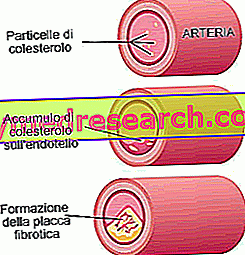What is atherosclerosis?
Atherosclerosis is a multifactorial degenerative disease that affects medium and large caliber arteries, inflaming and stiffening them due to the deposition of fat and white blood cells in their wall. These deposits (called atheromas or atherosclerotic plaques) are deposited in the innermost layer of the arteries, the one in direct contact with the blood.
In Italy and in many other countries of the world, atherosclerosis is a major health problem, mostly linked to the lifestyle typical of industrialized societies. In fact, atherosclerosis is the cause or contributing cause of very serious pathologies, such as angina pectoris, heart attack and stroke.
Why is it dangerous?
Often, atherosclerosis is described in a simplistic way as a pathology linked to fatty deposits on the walls of the arteries which, with the passage of time, increase in volume reducing their elasticity and hindering the blood flow. In reality, very often, it is not the occlusion of the artery itself that causes the infarct but the inflammation and consequent rupture of these fat deposits (called atheromas or atherosclerotic plaques).
When the superficial wall of the plaque breaks down, the blood comes into contact with the cholesterol contained in it. This process leads to the formation of a clot, just like when we get a wound. Within the artery the coagulation mechanisms thus give rise to a hard substance (thrombus or caugulum), which can interrupt the blood flow causing a sudden enlargement of the plaque.
Due to the lesion, a piece of atheroma may also come off and, transported to the periphery by the blood, it would occlude smaller vessels (embolism).
The reason why some plaques break is mainly related to their chronic inflammation.
Insights
Causes of atherosclerosis Symptoms and treatments Medications for the treatment of atherosclerosis Diet and atherosclerosis Supplements for atherosclerosisFats, health and atherosclerosisHow is Atherosclerosis formed?
Cholesterol is a fat and as such cannot dissolve in the blood. For this reason it is transported in circulation by some specific proteins. Some of these, called LDLs, transport it from the liver to various tissues, where it is used for cellular metabolic processes.

If it is present in excess, cholesterol linked to LDL tends to remain in circulation for a long time and to slip immediately below the inner surface of the artery in question. Once entered here the LDL undergoes modifications by oxidizing and increasing the permeability of the vascular endothelium to monocytes and T lymphocytes (particular types of white blood cells) which thus migrate inside the wall.
Over time these cells evolve into macrophages and ingest the oxidized LDLs accumulating lipid vacuoles in the cytoplasmic space (foam cells or foam cells).
Foam cells secrete inflammatory substances and growth factors that induce proliferation of smooth muscle cells. This situation leads to the formation of a fibrous capsuala that covers the adipose accumulation. Fibrolipid plaques are generated during the silent phase of atherosclerosis, which can last for decades.
These plaques are dynamic, evolving structures and atherosclerosis events are extremely variable and complex.
In the most serious cases the fibrous plaques may undergo further complications due to the deposition of calcium crystals and subsequent calcification (obstruction of blood flow), or due to the development of fissures, hematomas and thrombi, responsible for the clinical phenomena of atherosclerosis (infarction, angina unstable, stroke etc.).
The evolution of atherosclerosis is strongly linked to the lipid and macrophage content of the plaque and a high presence of these two elements increases their susceptibility to rupture.
The cardiovascular risk is therefore linked both to the size of the plaques and to their inflammation . Relatively small but inflamed plaques are more dangerous than large plates that are not inflamed.
C-reactive protein
A non-specific indicator of the inflammatory process is the C-reactive protein or PCR . Levels of this protein are generally high in those who suffer a heart attack and at the same cholesterol level they risk more patients with above average PRC levels.
The increase in these values can be linked to inflammatory phenomena of various kinds (tonsillitis, bronchitis, pneumonia, etc.). To assess the cardiovascular risk it therefore becomes extremely important to perform the test in conditions of perfect health, possibly repeating it a short distance of time.
The PCR value - together with that of total cholesterol and HDL, blood glucose, blood pressure and lifestyle analysis (smoking, stress, physical activity, etc.) - can give an idea of what the cardiovascular risk is of the subject.



